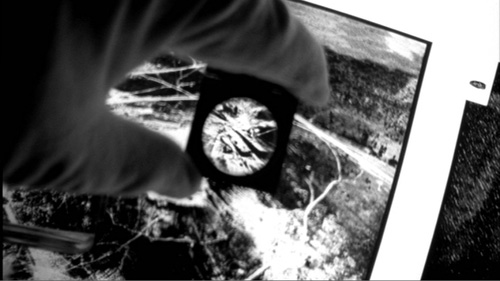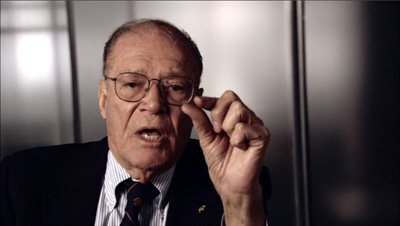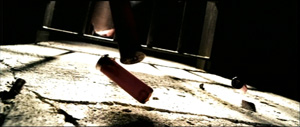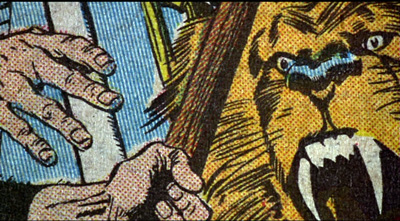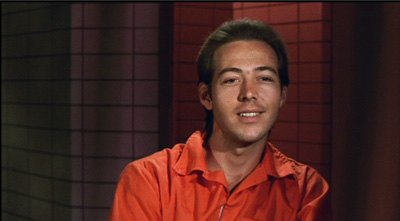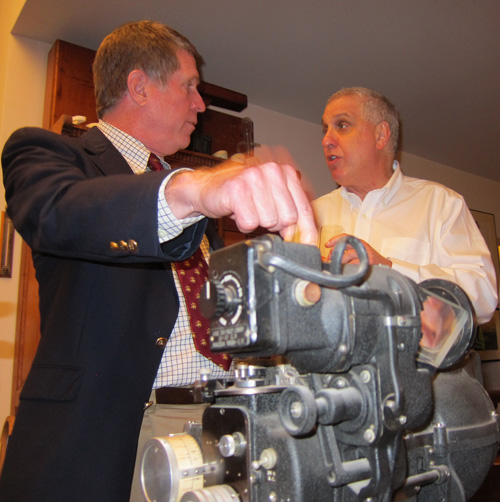Errol Morris, boy detective
Thursday | November 4, 2010 open printable version
open printable version
The Fog of War: Eleven Lessons from the Life of Robert S. McNamara.
DB here:
Over a couple of sunny days in late October Errol Morris visited the University of Wisconsin—Madison. It was something of a homecoming. Morris took his BA in history here, and was inspired by two legendary teachers, Harvey Goldberg and George L. Mosse. (“The UW saved my life.”) After a few years in graduate schools (Princeton, Berkeley), he went into filmmaking, working with Werner Herzog on Stroszek while it was shooting in Wisconsin.
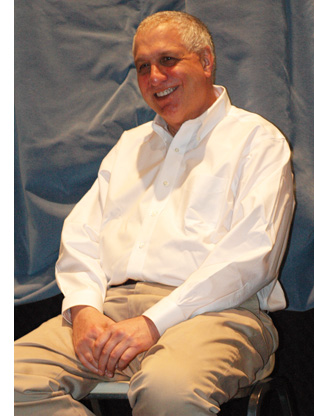 Morris’s first film, Gates of Heaven (1978), examined pets, their owners, and the cemeteries that cater to both. Vernon, Florida (1981) reinforced Morris’s reputation as an aficionado of the backwoods bizarre. His reputation widened with The Thin Blue Line (1988), a true-crime story that cast doubt on whether an innocent man had been imprisoned for a murder. I’d argue that this film, along with Roger and Me, played a crucial role in opening theatrical markets to documentary film. From then on, Morris has been acclaimed as one of our finest filmmakers, finally receiving an Academy Award for The Fog of War (2003), a study of Robert McNamara’s prosecution of the war in Vietnam.
Morris’s first film, Gates of Heaven (1978), examined pets, their owners, and the cemeteries that cater to both. Vernon, Florida (1981) reinforced Morris’s reputation as an aficionado of the backwoods bizarre. His reputation widened with The Thin Blue Line (1988), a true-crime story that cast doubt on whether an innocent man had been imprisoned for a murder. I’d argue that this film, along with Roger and Me, played a crucial role in opening theatrical markets to documentary film. From then on, Morris has been acclaimed as one of our finest filmmakers, finally receiving an Academy Award for The Fog of War (2003), a study of Robert McNamara’s prosecution of the war in Vietnam.
Morris’ visit was the culmination of months of screenings in several Madison venues. The big weekend was ushered in by a lecture by Carl Plantinga, one of our most distinguished scholars of documentary film. He’s a professor at Calvin College, and like Morris, he’s a Wisconsin graduate (my Ph. D. student, ahem). Dave Resha, who wrote a dissertation on Morris, and Bill Brown, our accomplished documentarist, were on hand to join our guest on a panel. Perky and boyish, Morris offered a public lecture at the Student Union. Next day, the Madison Museum of Contemporary Art hosted a screening of his new movie Tabloid and a Q & A.
Morris is an exuberant presence, onstage and off. I could fill this entry with one-liners and anecdotes.
My high-school guidance counselor told me, “You should go to Wisconsin. They take anybody.”
I sometimes think of myself as someone who should be beaten up a lot.
Just because he’s a victim doesn’t mean he isn’t an asshole.
The electric chair is a very scary thing.
My wife says I should give up Twitter and start writing for fortune cookies.
Fred Leuchter, electric-chair repairman and Holocaust denier, smokes constantly but won’t be filmed with a cigarette. He explains, “You have to understand, Errol. I’m a role model for children.”
I don’t think anybody knows how crazy they are. I include myself and the persons in this room.
Morris’s visit was so stimulating that it got me thinking afresh about his career. While many documentaries engage in fact-finding, Morris’s films recall for me the figure of the classic detective, the nosy fellow drawn to secrets high and low. Morris is a fan of film noir (he thinks that Detour is at least as good as Citizen Kane) and he worked for a time as an investigator. His only fictional film, The Dark Wind (1991), is adapted from a Tony Hillerman mystery. It’s useful to think of Morris’s documentaries as private investigations—not illustrating an argument but exploring the mysteries around a situation or a personality. Like any investigation, his may lead nowhere or create more puzzles than it solves. Morris shines his penlight in some dark places, finding not only clues but some embarrassing items in the drawer or the back of the closet. The truth often has a sordid side, but that can harbor its own pleasures.
The filmmaker and the murderer
The Fog of War: “Rational individuals came that close to total destruction of their societies.”
History is a crime scene, and you’re the detective. Film can be a tool to solve the mystery.
Errol Morris
Morris’s recent films on the Vietnam War and on the abuses at Abu Ghraib prison (S. O. P.: Standard Operating Procedure, 2008) are somber inquiries into the mechanics of power and bureaucracy. Balzac said that behind every great fortune lies a great crime; for Morris behind every war lies many such crimes. Early on McNamara admits that his misjudgments cost thousands of lives. Morris’s reconstructions of prisoner treatment at Abu Ghraib are chilling neo-noir, filmed in chiaroscuro and featuring agonizing slowed-down imagery, as when a shotgun is fired into a cell and shells tumble out of the chamber.
He’s particularly interested in the photos snapped by the Abu Ghraib guards, and they provoked him to his lengthy New York Times blog essays on the philosophy of photography. S.O.P. and his writings ask how reliable a photograph is, how we can so easily miss what’s before us, and how what’s really happening–the chain of command, the war crimes that aren’t photographed, even another witness–can be hidden by the images we make. He often invokes a soldier’s remark about the Abu Ghraib pictures: “When you see a picture, you never see what’s outside the frame.”
The philosophical quests in Morris’s work lay at the center of Carl Plantinga’s presentation, “Errol Morris and the Anosognosic’s Guide to Documentary Film.” Carl trained as a philosopher, and his lecture teased out many concerns that weave through Morris’s work. On his website, Morris has written about anosognosia, the condition of not knowing that you don’t know something. It’s the realm of Donald Rumsfeld’s “unknown unknowns.” Anosognosia, Morris claims, is “a universal condition of the human race.”
Carl’s talk developed this idea along several lines. Morris, he suggested, is a critical realist who believes that reliable knowledge is in principle attainable, even though we seldom attain it. Accordingly, Carl suggested, the films expose the mistaken beliefs of his subjects, their “epistemic distortions” revealed in behavior and, especially, language.
But the pathway to truth can’t be the cinéma-vérité methods of straightforward recording, if only because simply turning on the camera won’t give us access to the “mental landscapes” his speakers inhabit. For Carl, Morris deals in tragicomedy—sometimes bleak, sometimes absurdist, sometimes tinged with “fellow feeling.” His films can seem denunciatory, but they pause for moments of sympathy: a trial lawyer quits practice when justice is outrageously miscarried, the grunts at Abu Ghraib are scapegoated.
Carl invoked a controversy that has played out in academic circles but that Morris obviously feels passionate about. It centers on The Thin Blue Line. That film, some scholars argued, was a “postmodern” documentary. The conflicting testimony, rambling digressions, and incompatible replays seemed to display a corrosive skepticism about what really happened on the night that Officer Robert Wood was shot on a lonely Texas highway. Morris had apparently made a film about the impossibility of finding truth. Perhaps Morris encouraged that interpretation by remarks like this:
I like the irrelevant, the tangential, the sidebar excursion to nowhere that suddenly becomes revelatory. That’s what all my movies are about. That and the idea that we’re in a position of certainty, truth, infallible knowledge, when actually we’re just a bunch of apes running around.
Since then, though, Morris has been at pains to insist that The Thin Blue Line doesn’t say that arriving at a truth is impossible, only that it’s damnably difficult. Unlike the preformatted rhetorical documentary, a Morris film starts out from an uncertain place and moves into unknown territory. We may not arrive at certain truth or infallible knowledge, but that doesn’t mean that we’re forever floating in a realm in which belief in ghosts is as valid as belief in atoms. Randall Adams did not shoot Officer Wood, and David Harris probably did. Approximate but reliable truths are likely as close as we’ll get, and even those are very hard won. This is one reason Carl calls Morris a “critical realist”: There is a real world and there are true things to be said about it, but there are never any guarantees that we’ll find them.
Hence, again, the figure of the detective. The P. I. searches for the truth. The result may be partial, or vague, or so thickly wrapped in falsehood that it seems a pitiful thing. The trail is cluttered with distractions. With The Thin Blue Line, Morris developed a story line, starting with Randall Adams’ arrival in Dallas and ending with David Harris’s chillingly casual suggestion, captured on tape, that he was the guilty party.
The interviews provided the spine of Morris’s tale. But he embellished the interviews with inserts of documents (newspapers, police records), reenactments, and other images, some of them apparently irrelevant to the case: road maps, a drive-in’s popcorn machine, clips from Boston Blackie movies. In the terms we propose in Film Art, he gave his narrative form doses of associational form.
One function of this vagrant material is to remind us what any private dick knows: You have to sift through a lot of detritus to get to the important facts. (This idea seems literalized in the floating feathers and clumps of dust that irradiate the cell block in S. O. P.) Sometimes the detritus buries the facts, and you miss out. But some inquiries make progress. “It’s not just about constructing stories,” Morris says, “but finding things out.”
Morris’s films aren’t necessarily full records of an investigation but rather soundings and probes. The movies assemble, in provocative form, promising leads, false trails, and clues that are striking but still inscrutable. Sometimes what’s out of the frame is crucial. The viewer of The Thin Blue Line is likely to think that Harris’s climactic half-confession is what won Adams’ reprieve. In fact the decisive material was footage not in the final movie, drawn from interviews with Emily Miller and Michael Randell, along with proof that evidence was suppressed at Adams’ trial. As Morris is fond of saying, “What freed him was not the movie but the investigation.”
The lure of the lurid
Fast, Cheap, and Out of Control.
What amazed me was the number of murderers who’d come from Plainfield and the surrounding areas, so I started interviewing them, too . . . . At the time I remember my mother asking me why I didn’t spend time with people my own age. I said, “But mom, the murderers are my own age.”
Errol Morris
Emphasizing Morris’s search for truths may make him seem a more genteel filmmaker than he actually is. Another side of his work is an unabashed sensationalism. When I said to him, “You’re preoccupied with the weirdness of things,” he corrected me: “No, the profound weirdness of things.” The world is just plain strange (that’s part of what makes truth hard to get to) and it’s strange all the way down.
Morris has an appetite for free-range surrealism. Vernon, Florida began as an inquiry into a town whose citizens displayed a penchant for hacking off their arms and legs. (Pitching a fictional version, Morris proposed the one-sheet tagline: “If they would do this to themselves, think of what they would do to you.”) He has been intrigued by spontaneous human combustion, people struck by lightning, the search for Einstein’s brain, the breeding of giant chickens, and the efforts of a Minnesota man to build his own interstate highway.
At the limit stand figures preoccupied with end-of-life concerns—that is, the ending of other people’s lives. Morris’s time in Wisconsin with Herzog led him to Ed Gein, our state’s most famous grave-robber and the prototype for Norman Bates. Pretending to be psychiatrists, Morris and Herzog interviewed a serial murderer in California. Later, after working as a P. I., Morris heard of “Dr. Death,” a psychiatrist who specialized in testifying to the sanity of convicts on Death Row. A perfect subject for a movie, Morris thought, and checking into Dr. Death’s record he found Randall Adams’ case.
Morris’s cheerfully morbid curiosity, which puts him in the company of Dr. Hunter S. Thompson, Ed Regis, and, of course, Herzog, is channeled into subjects that a high schooler might choose for a book report. Baby-boomer men, brought up on the Hardy Boys and Popular Science, are perpetual kids. Anything to do with magic, mystery, snooping, and weird science holds us fascinated. I’d bet that Morris has a set of William Poundstone’s wondrous Big Secrets books. How did he miss tackling UFOs?
So Morris is a connoisseur of weird science and lethal battiness. But it’s all in a day’s work for a P. I. The detective is inevitably drawn to seaminess, curiosities, and compulsions. Things that shock or disgust or baffle us can be clues to something we’d rather not face. In Morris’s hands, material that would shriek at us from supermarket racks can turn grotesquely comic (the early films), ominous (Thin Blue Line, Mr. Death), or strangely poetic (A Brief History of Time; Fast, Cheap, and Out of Control).
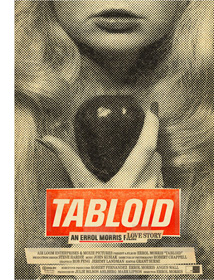 Come to think of it, Fast, Cheap, and Out of Control would also be a good title for Tabloid. Joyce McKinney’s saga has enough spice for a full issue of Weekly World News: beauty contests, religious mania, kidnapping, bondage, flight from the law, cloned puppies, and Joan Collins. There are moments that demand blunderbuss typeface. I still want my Mormon! He was a doo-doo dipper! Booger gave me five black jellyrolls! And no reenactments now, just interviews enhanced by found footage, snapshots and headlines hurled into the frame. Once we’re dizzied from the bombardment of alluring phrases (Manacled Mormon Sex Slave!), we’re yanked into a circulation battle. The Mirror and the Express are deploying operatives to buy stories that will undercut each other.
Come to think of it, Fast, Cheap, and Out of Control would also be a good title for Tabloid. Joyce McKinney’s saga has enough spice for a full issue of Weekly World News: beauty contests, religious mania, kidnapping, bondage, flight from the law, cloned puppies, and Joan Collins. There are moments that demand blunderbuss typeface. I still want my Mormon! He was a doo-doo dipper! Booger gave me five black jellyrolls! And no reenactments now, just interviews enhanced by found footage, snapshots and headlines hurled into the frame. Once we’re dizzied from the bombardment of alluring phrases (Manacled Mormon Sex Slave!), we’re yanked into a circulation battle. The Mirror and the Express are deploying operatives to buy stories that will undercut each other.
At some point we’re engulfed, and the tabloids become an alternative reality of magical transformations. An innocent girl, radiant in her own home movie, becomes a felon, and then her real transgressions come to light. The tabs’ endless escalation of sordidness, with each week’s scandal trumped by the next, gives the movie its pounding rhythm, the tempo of the rotary presses pumping out—what else?—stories that bury truth under trivia.
Except that this time around, the trivia are all we have, and the obsessiveness of the young McKinney is matched by that of the reporters pursuing her. Captured in pitiless high-definition, the men’s seamed faces glow with self-satisfaction and the thrill of the hunt. True, they’re investigators like Morris, and one journalist elicits some actual conversation with our offscreen filmmaker. (They discuss the phrase “barking mad,” which Morris wishes Americans used more often.) After a while, though, we can add these Grub Streeters to Morris’s gallery of people who talk and talk without any sense of what they’re giving away.
The great mystery
The Thin Blue Line.
Even as [the writer] is worriedly striving to keep the subject talking, the subject is worriedly striving to keep the writer listening. The subject is Scheherazade. He lives in fear of being found uninteresting, and many of the strange things that subjects say to writers—things of almost suicidal rashness—they say out of their desperate need to keep the writer’s attention riveted.
Janet Malcolm
The detective, by vocation, asks questions. A detective-story plot consists largely of following the investigator pounding the path, interrogating witnesses, suspects, and experts. (With time out for occasional pistol ambushes, seductions, and whacks on the back of the head.) What people say and how they say it can lead you to truth, or to the profound weirdness that informs the human condition, or both.
Hence the very special conditions for a Morris interview. Complex lighting, and in the later films artificial backdrops, create the aura of a special occasion. Hair and make-up are attended to. Up to twenty crew members are at work. Looming in front is the Interrotron, that mad-scientist rig of mirrors that lets the interviewee look at Morris while also looking into the camera. In a later development, several cameras are trained on the speaker. In all, it’s not quite like being dragged to sit in the hot seat at Headquarters, but there is an almost ceremonial surrender of autonomy. All the subject can do is talk, and aim it directly at us.
Morris does not provide questions in advance. He starts by saying, “I don’t know where to start.” He doesn’t pounce on his subjects (he calls them his “characters”). He speaks as little as possible, regarding it as best to let the people gabble on. Thanks to videotape, they can talk uninterrupted for hours. We seldom hear his questions. He never comes on camera to make himself the protagonist or star (à la Moore), nor does he provide a stream of voice-over narration (à la Curtis). We have simply to look at these people and listen to what they say.
During his stay in Madison, Morris referred often to the case of Scott MacDonald, the convicted murderer whose case journalist Joe McGinnis turned into a bestseller. Of particular interest to Morris was Janet Malcolm’s book about the case, The Journalist and the Murderer. MacDonald sued McGinnis for seeming to support his case during the trial, then publishing a damning account declaring MacDonald guilty as charged. Analyzing MacDonald’s litigation, Malcolm reflects on the betrayal at the heart of journalistic inquiry. The subject interviewed wants the story told his or her way; the writer, at least the writer of conscience, can never fulfill that pledge. The naivete of the subject is always shattered when the story is published, for the writer had another agenda.
Malcolm’s book intersects Morris’s concerns at several points: a tabloid murder, a man perhaps wrongly convicted, a subject sueing the writer (as Randall Adams eventually sued Morris). In particular, I think that Morris is taken with the idea that interviewees have a kind of compulsion to keep talking. They want to explain themselves fully, of course, and to justify what they’ve done. But they also want to prove themselves worthy of someone else’s interest. Compulsive confessors, they want to be caught and are always startled when they are.
Morris’s ultimate interest, Carl Plantinga noted, lies in people’s “mindscapes,” their private construals of reality. Morris seemed to agree. The great mystery, he said, is “human personality, who we are.” That includes all the madness and dirt. The surprises that pop out, Interrotron or no Interrotron, remind us that we’ll never completely crack the case.
For much more on Morris, visit his website. He tweets here. His New York Times essays on photography are now evidently behind a paywall, but an all-out search will reveal some of them. Here is a pdf of what I think is the first one. A more recent cycle starts here. A book of Morris essays is planned for publication.
The best compendium of Morris’s evolving ideas is Livia Bloom’s collection Errol Morris Interviews (University of Mississippi Press, 2010). From this book, I’ve quoted Morris’s remarks in Chris Chang’s 1997 Film Comment article “Planet of the Apes,” p. 56, and in Paul Cronin’s wide-ranging “It Could All Be Wrong: An Unfinished Interview with Errol Morris,” p. 165. My quotation from Janet Malcolm’s The Journalist and the Murderer is from pp. 19-20.
Carl Plantinga’s Rhetoric and Representation in Nonfiction Film has recently come back into print, and I discuss it briefly in a recent entry.
I wrote an analysis of The Thin Blue Line in Film Art, ninth edition, pp. 425-431. We contrast Morris with Michael Moore and other documentarists in Film History: An Introduction, third edition, pp. 544-548.
The Wisconsin symposium, Elusive Truths: The Cinema of Errol Morris, was a model of campus cooperation. Thanks to the Wisconsin Union, and especially the dedicated students of the WUD Distinguished Lecture Series, the Madison Museum of Contemporary Art, our Cinematheque, the University of Wisconsin Foundation, the UW Arts Institute, and other agencies, not least my home Department of Communication Arts. We owe a special debt to Professor Vance Kepley who orchestrated the event with aplomb. A full record of events, sponsoring bodies, and people to be grateful to can be found here.
Vance Kepley and Errol Morris discuss the once-top-secret Norden bombsight.












